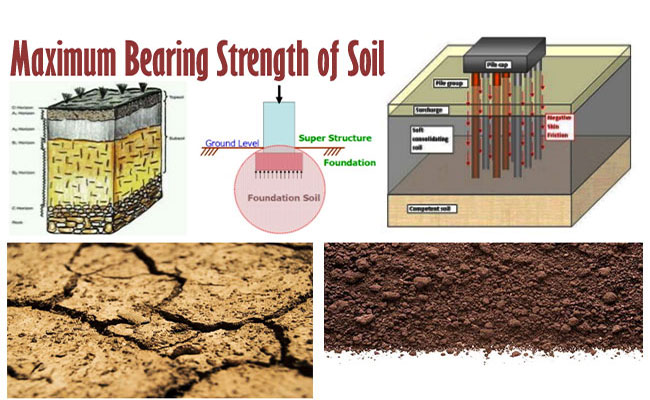Maximum bearing capacity of soil

This civil engineering article provides brief explanation about different types of soils and their maximum bearing strength.
There are two types of bearing capacity of soils i.e. ultimate bearing capacity and safe bearing capacity.
Ultimate bearing capacity – When load applied on soil, the minimum pressure that would induce the shear failure of the supporting soil beneath and close to the foundation right away.
Sage bearing capacity - The maximum pressure that the soil can bear securely devoid of any shear failure is defined as the safe bearing capacity. It is equivalent to the net safe bearing capacity along with original overburden pressure. Often, the safe bearing capacity is also known as the ultimate bearing capacity gf divided with a factor of safety F.
The bearing capacity of soil is determined with the following methods:-
Dropping weight method – Under this method, an object of known weight is dropped from a known height. The intensity of impression produced by the weight on the soil is recorded. After that the bearing capacity of soil is measured in following manner:-
Ultimate resistance of soil
R = w x h / d
Here, R denotes resistance of soil; w denotes weight of object and h denotes height.
Slowly applied load method – Under this method, the load is applied slowly on the soil to determine the bearing capacity of soil.
Given below, the maximum bearing capacity of several types of soils:-
There are 14 types of soils and their bearing capacities are as follow:-
Soft Clay - 10,000 kg/m2
Soft, wet clay or muddy clay - 5,000 kg/m2
Fine, loose and dry sand - 10,000 kg/m2
Black Cotton soil - 15,000 kg/m2
Moist clay and sand clay mixture - 15,000 kg/m2
Medium clay - 25,000 kg/m2
Loose gravel - 25,000 kg/m2
Compact clay - 45.000 kg/m2
Compact clay - 45.000 kg/m2
Compact sand - 45,000 kg/m2
Soft rock - 45,000 kg/m2
Compact gravel - 45,000 kg/m2
Laminated rock like sand stone & lime stone - 165,000 kg/m2

